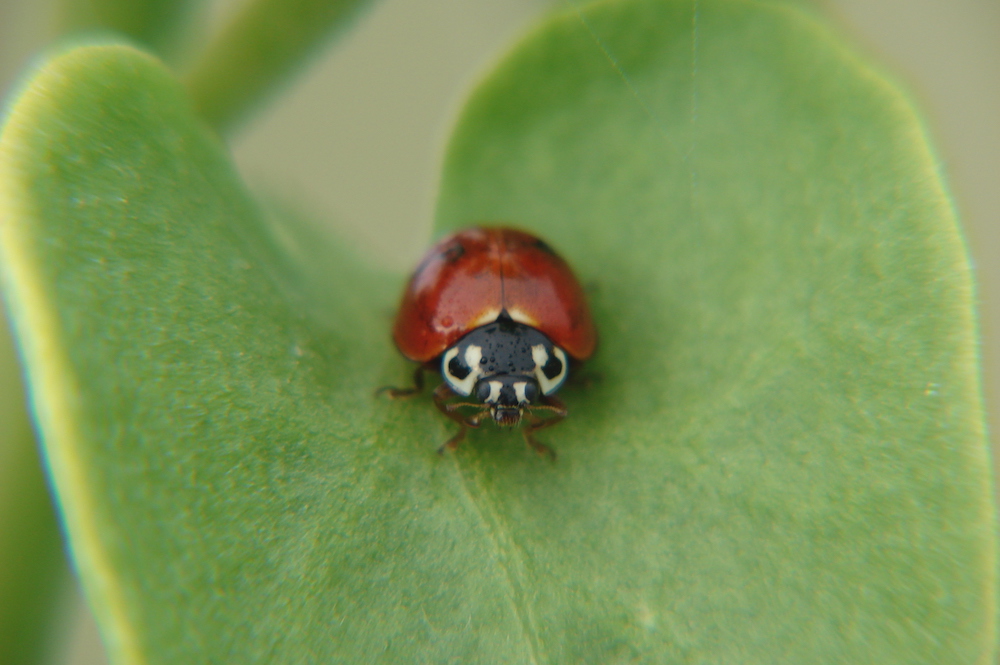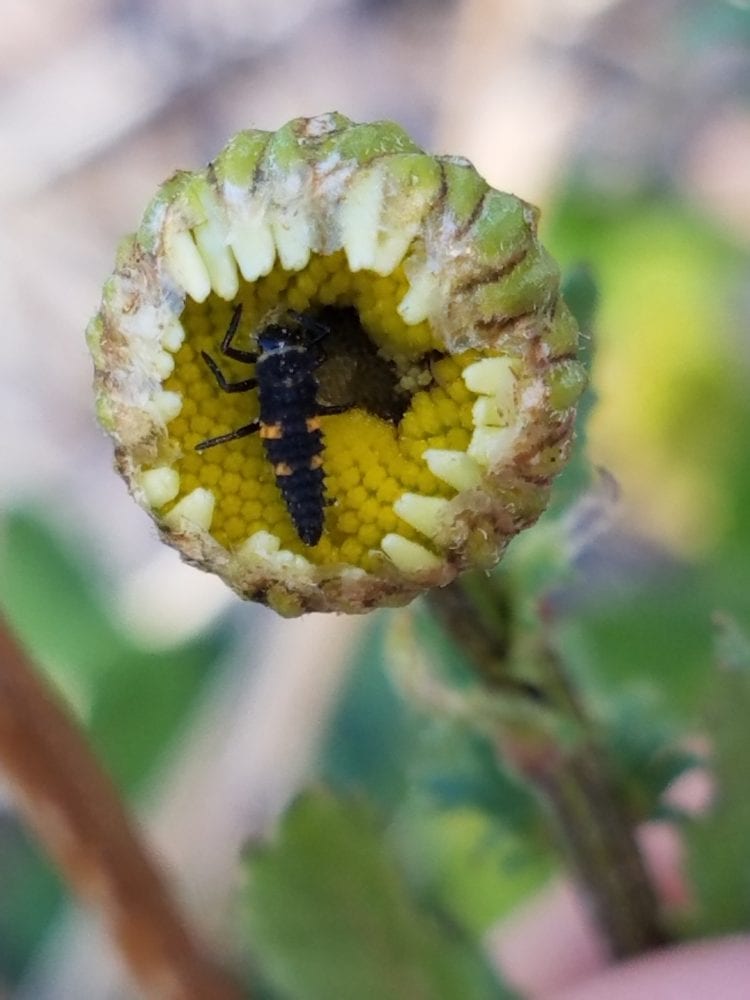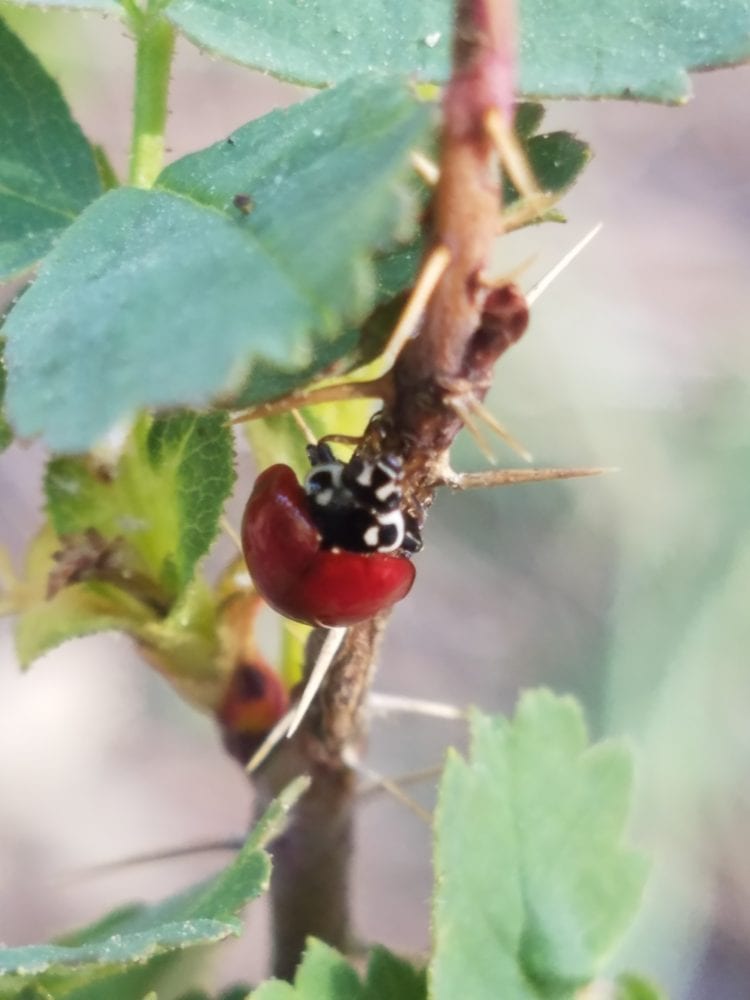
By Aislinn Marshall and Liv Niklasson
You may know ladybugs for their pretty colors, but there is much more to them than meets the eye. They are vicious predators, able to eat thousands of aphids in their lifetime. They also go through a life cycle that is at least as interesting as a butterfly’s.

There are about 5,000 species of ladybugs all around the world. They can survive in practically any climate, and can live for up to 9 months without food! The most common species of ladybug in North America is the convergent ladybug (Hippodamia convergens). They live for about a year.
The first stage of a ladybug’s life cycle is the same as most bugs: eggs. Ladybug eggs are bright yellow. The females lay eggs in bunches of about 5 – 50, on the undersides of leaves to protect them from flying predators and the weather. They lay eggs many times per season; a female lays about 1,000 eggs in her lifetime. Both fertile and infertile eggs are included in a bunch, so that when the fertile ones hatch, the larvae can eat the infertile eggs. The time it takes for them to hatch can range from 2 – 10 days, depending on the temperature.
The next stage of the ladybug life cycle is the larval stage. The larvae eat a lot, and their diet includes scale insects, aphids, adelgids, and insect eggs. They are black with yellow spots, and molt four times before pupating. The larval stage lasts for about a month, and when they are ready to pupate, they attach themselves to the undersides of leaves.
The third stage in a ladybug’s life is the pupa. The shell is orange with black spots, and is roughly the same shape as an armadillo shell. While it might seem boring on the outside, the things happening inside the shell are probably the most interesting parts of a ladybug’s life. In the pupa, the larva is broken down completely before the adult forms. The change is controlled by cells called histoblasts, kind of like the hormones that give boys deeper voices or girls wider hips. This entire process takes from 1 – 2 weeks.

The final stage of a ladybug’s life is an adult. When they come out of their pupae, their shells are a pale gray-green color and their exoskeletons are soft. This makes them vulnerable to predators until it hardens. They eat the same food as the larvae, so they usually live on aphid-infested plants. They can produce a bad-smelling and tasting liquid from their joints to make themselves undesirable meals to birds, skunks, and other hungry predators.
They fly when temperatures exceed 55 degrees Fahrenheit, and when spreading or closing their wings, they fold them like origami so that they fit under their shells. Ladybugs spend the winter in hibernation. They sleep in large groups in cracks and crevices, such as in the bark of a tree, and mate as soon as they wake up.
Someday in the spring or early summer, go outside and try to find ladybugs in all stages of their life. Look for a plant infested with aphids, or other similar bugs. Look under the leaves for eggs and pupae. Look in the clumps of aphids for larvae and adults. You will usually find ladybugs in all four stages of their life on one plant, or at least in the same area. In the winter, go out and look in fallen logs, tree bark, or any other cracks for hibernating adults.
Watch this fascinating video to see the whole life cycle of a ladybug unfold!

Aislinn and Liv, Thank you for writing the interesting and informative blog about ladybird beetles. As a lifelong gardener, I have always valued having as many ladybugs as possible on my vegetable and flower plants. I learned some new things about their life cycle by reading your story, and I look forward to using the new information to try to have even more ladybugs in the future.
Great post! I have definitely smelled ladybugs and was not a fan. Beautiful photos, Liv!
Good work Aislinn and Liv! I certainly learned a lot about ladybugs from your post. Good photos too.
Liv and Aislinn, I learned a great deal from your article. I have always been a fan of lady bugs and as soon as it warms up here in Maine, I will take your challenge and explore the yard and garden to try and find them in all stages of their life cycle.